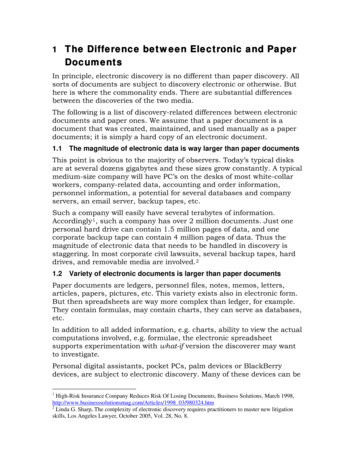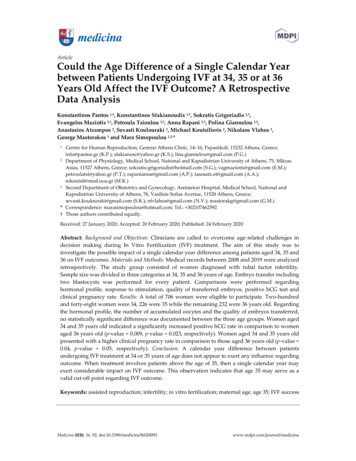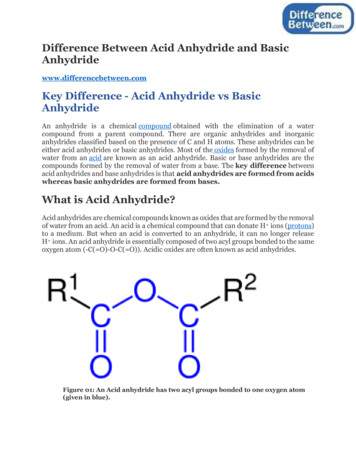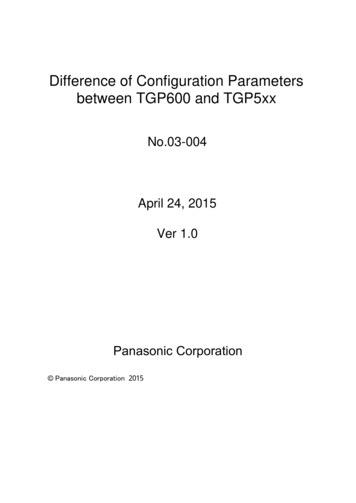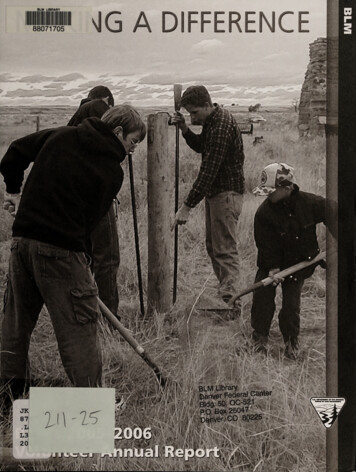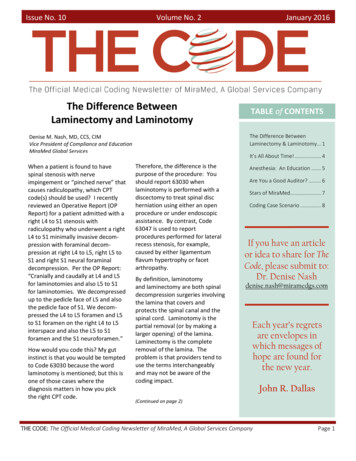
Transcription
Issue No. 10Volume No. 2The Difference BetweenLaminectomy and LaminotomyJanuary 2016TABLE of CONTENTSNote from TonyThe Difference BetweenLaminectomy & Laminotomy. 1Denise M. Nash, MD, CCS, CIMVice President of Compliance and EducationMiraMed Global ServicesWhen a patient is found to havespinal stenosis with nerveimpingement or “pinched nerve” thatcauses radiculopathy, which CPTcode(s) should be used? I recentlyreviewed an Operative Report (OPReport) for a patient admitted with aright L4 to S1 stenosis withradiculopathy who underwent a rightL4 to S1 minimally invasive decompression with foraminal decompression at right L4 to L5, right L5 toS1 and right S1 neural foraminaldecompression. Per the OP Report:“Cranially and caudally at L4 and L5for laminotomies and also L5 to S1for laminotomies. We decompressedup to the pedicle face of L5 and alsothe pedicle face of S1. We decompressed the L4 to L5 foramen and L5to S1 foramen on the right L4 to L5interspace and also the L5 to S1foramen and the S1 neuroforamen.”How would you code this? My gutinstinct is that you would be temptedto Code 63030 because the wordlaminotomy is mentioned; but this isone of those cases where thediagnosis matters in how you pickthe right CPT code.It’s All About Time! . 4Therefore, the difference is thepurpose of the procedure: Youshould report 63030 whenlaminotomy is performed with adiscectomy to treat spinal discherniation using either an openprocedure or under endoscopicassistance. By contrast, Code63047 is used to reportprocedures performed for lateralrecess stenosis, for example,caused by either ligamentumflavum hypertrophy or facetarthropathy.By definition, laminotomyand laminectomy are both spinaldecompression surgeries involvingthe lamina that covers andprotects the spinal canal and thespinal cord. Laminotomy is thepartial removal (or by making alarger opening) of the lamina.Laminectomy is the completeremoval of the lamina. Theproblem is that providers tend touse the terms interchangeablyand may not be aware of thecoding impact.Anesthesia: An Education . 5Are You a Good Auditor? . 6Stars of MiraMed . 7Coding Case Scenario . 8If you have an articleor idea to share for TheCode, please submit to:Dr. Denise Nashdenise.nash@miramedgs.comEach year’s regretsare envelopes inwhich messages ofhope are found forthe new year.John R. Dallas(Continued on page 2)THE CODE: The Official Medical Coding Newsletter of MiraMed, A Global Services CompanyPage 1
Issue No. 10Volume No. 2January 2016The Difference Between Lamnectomy and Laminotomy (Continued from page 1)When the laminectomy or laminotomy is performed primarily for herniated discs and the decompression procedure isnot the primary reason, CPT Codes 63020/63030 are used. When the laminectomy or laminotomy is performedprimarily for spinal stenosis, the decompression procedure is the primary focus and if only a minor discectomy or nodiscectomy is performed in the procedure, then Codes 60345 or 63047 would be used.CPT Code 63030 is defined as laminotomy (hemilaminectomy), with decompression of nerve root(s), including partialfacetectomy, foraminotomy and/or excision of herniated intervertebral disc; one interspace, lumbar (including open orendoscopically-assisted approach) and; Code 63047, laminectomy, facetectomy and foraminotomy (unilateral orbilateral with decompression of spinal cord, cauda equina and/or nerve root(s) (e.g., spinal or recess stenosis), singlevertebral segment, lumbar. They seem the same other than the utilization of laminotomy or laminectomy and code63030 includes “and/or excision of herniated intervertebral disc.” CPT explains that laminectomy is a surgical procedurefor treating spinal stenosis by relieving pressure on the spinal cord. The surgeon removes or trims the lamina to widenthe spinal canal and create more space for the spinal cord and spinal nerves. So even if the surgeon uses the wordlaminotomy, he is still decompressing the nerve preventing radiculopathy.Use CPT 63045 for cervical or CPT 63047 for lumbar, with additional levels billed with add-on Code 63048 unilateral orbilateral. In this procedure, the physician removes the spinous process. If the stenosis is central, the lamina may beremoved out to the articular facets using a burr. If the compression is in the lateral recess, only half of the lamina isremoved. The ligamentum flavum is peeled away from the dura. Nerve root canals are freed by additional resection ofthe facet, and compression is relieved by removal of any bony or tissue overgrowth around the foramen. Removal ofthe lamina, facets and bony tissue or overgrowths may be performed bilaterally, when indicated. Do not use the -RT, -LTor -50 modifiers with these codes.So in the case above, the first listed diagnosis for this patient would be M46.07 Spinal stenosis, lumbosacral region.ICD-9-CM724.4 Thoracic or lumbosacral neuritis orradiculitis, unspecified724.02 Spinal stenosis, lumbar region,without neurogenic claudication724.03 Spinal stenosis, lumbar region, withneurogenic claudicationICD-10-CMM54.14 Radiculopathy, thoracic regionM54.15 Radiculopathy, thoracolumbar regionM54.16 Radiculopathy, lumbar regionM54.17 Radiculopathy, lumbosacral regionM48.036 Spinal stenosis, lumbar regionM48.07 Spinal stenosis, lumbosacral regionM99.23 Subluxation stenosis of neural canal oflumbar regionM99.43 Osseous stenosis of neural canal oflumbar regionM99.53 Intervertebral disc stenosis of neuralcanal of lumbar regionM99.63 Osseous and subluxation stenosis ofintervertebral foramina of lumbarregionM99.73 Connective tissue and disc stenosis ofintervertebral foramina of lumbarregionM48.06 Spinal stenosis, lumbar regionG95.29 Other cord compression(Continued on page 3)THE CODE: The Official Medical Coding Newsletter of MiraMed, A Global Services CompanyPage 2
Issue No. 10Volume No. 2January 2016The Difference Between Laminectomy and Laminotomy (Continued from page 2)In coding the procedure, always remember the five steps in coding for spinal procedures which of course must besupported by the documentation found in the operative note.1.2.3.4.5.Location: cervical, thoracic, lumbar or sacral.Approach: anterior, posterior or lateral extra cavity or percutaneous.Pathology: what was done and medical indication (decompression, discectomy, corpectomy and arthrodesis).Instrumentation: rods, screws or cages.Bone grafting: allograft or autograft.Of course you also have to keep in mind that in a multiple-level decompression, the key to reporting is correlating thecorrect number to every root level being decompressed.1. Location: lumbar and sacral.2. Approach: posterior.3. Pathology: decompression.Since L4-5 and L5 to S1 were decompressed, the primary procedure would be CPT Code 63047 Laminectomy,facetectomy and foraminotomy (unilateral or bilateral) with decompression of spinal cord, cauda equina and/or nerveroot(s); single lumbar segment L4-5 and the secondary reported procedure would be CPT code 63048 Laminectomy,facetectomy and foraminotomy (unilateral or bilateral) with decompression of spinal cord, cauda equina and/or nerveroot(s); each additional segment lumbar L5 to S1. Per CPT, “It would be appropriate to report 63047 for the procedure,even though it describes a partial laminectomy only of the left lamina and foramen. The purpose of the procedure is torelieve spinal stenosis, which is the primary use of 63047.”Always remember that lumbar decompression codes are driven by the diagnosis as opposed to the technique involved.THE CODE: The Official Medical Coding Newsletter of MiraMed, A Global Services CompanyPage 3
Issue No. 10Volume No. 2January 2016IT’S ALL ABOUT TIME!Kim K. CapelloAdministrative AssistantMiraMed Global ServicesAre there ever enough hours in the day? As a full-time wife, mother and employee I have often wished for just onemore hour in each day. I found that my “Things To Do” were way longer than my “Just For Fun,” which meant that I wasall work and no play. After many years of trial and error I have found that the better the schedule, the better the life.Positive thinking is a major part of this plan.Start each day with confidence and selfassuredness. If you adopt this attitude everymorning you will be amazed at what all youcan accomplish. Even if you want to shootyour alarm clock, you will fare much better ifyou bound out of your bed and have your firstthought of the morning be: “Today is going tobe fantastic.” As you get ready for your day,which always includes at least one cup ofcoffee for me, make mental notes ofeverything you want to accomplish beforeday’s end. After each of these items enteryour mind, always follow up with thisthought: “I will be able to handle this with noproblem.” Don’t ever let a task go withoutbeing accompanied by a positive thought.Pre-planning for the next day is always a time saver. I am not a list maker. I have often attempted but have often failed.I find that I either forget my list or leave off something very important. If you are a good list maker, then by all means,make that list. What works best for me is going over in my mind the night before all that I wish to accomplish the nextday. Again, telling yourself that this will be a piece of cake is always advised.Don’t try and cram a large or daunting task in a short period of time. This often causes frustration and failure, andnegates every positive thought you’ve had that day. Instead, begin work early on projects that need to be completed bya deadline. Procrastination is the death of a well-ordered day. The perfect example is this article. It will take me severaldays to write this as I have allotted myself only the time it will take to write a paragraph or two each day before thedeadline. As I have started early, I will finish early. This allows me a proverbial pat on the back when the task iscompleted ahead of schedule.Keeping focus is a must! As mentioned earlier, I am a wife, mother and employee and those jobs are completely andtotally different. As an employee I keep my mind focused on the job at hand and do not let my thoughts wander to whatI am going to prepare that night for dinner or what my child may need for a homework assignment that afternoon.There is plenty of time for those thoughts on my drive home from work. Getting the job done at work leaves my mindfree of worries or concerns so that I can focus on family time at the end of the work day.These are just a few suggestions to plan a well-ordered day. After incorporating these ideas into your own life, I hopethat not only will you find that your days are free of stress, but that you will be amazed at all you have accomplished!THE CODE: The Official Medical Coding Newsletter of MiraMed, A Global Services CompanyPage 4
Issue No. 10Volume No. 2January 2016Anesthesia: An EducationAngelie Fajardo, RN, CCSSupervisor, Training DepartmentMiraMed Philippines Group, LLC - Philippine BranchBrief History:Did you know that surgery became one of the greatest fears of mankind? It was in the 18th century when surgery hadincreased in practice due to unknown diseases and conditions that took away countless lives. Unfortunately, no onewanted to undergo surgery due to its excruciating pain. Before anesthesia was introduced there were tremendousefforts done to deliver unconsciousness to a patient. Some surgeons used opium and marijuana, while others usedalcohol concoctions to knock out their patients. One technique that bewildered me was that early practitioners evenconsidered physically giving a blow to the patient's head to render unconsciousness. We all perceive that giving a blowto a patient's head has detrimental effects on our brain. So the pursuit for an effective anesthetic agent persevered.During the 18th century, the discovery of nitrous oxide (laughing gas) by English scientist Joseph Priestly brought tomedicine a drug that could alleviate pain. Other researchers introduced carbon dioxide which also has similar effectswith nitrous oxide. However, these gases were not potent enough.At last, in the year 1846, thefear of pain during surgery wascast out when a Boston dentist,William Thomas Green Morton,used another gas called sulfuricether. He had experimented onvarious animals and some dentalpatients. On October 16, 1846,Morton and a renownedsurgeon, John Collins, performedan operation to remove a tumorfrom a patient's neck. Theoperation was successful andthe surgery was painless. Thiswas the first time he utilizedimpervious and cogent“anesthesia.”In every milestone andaccomplishment of medicine,anesthesia has become the mostused; and the potential to harmhumans is very minimal.THE CODE: The Official Medical Coding Newsletter of MiraMed, A Global Services CompanyPage 5
Issue No. 10Volume No. 2January 2016Are You a Good Auditor?John Christian Sayo, RN, COC-A,Inpatient Trainer, Training DepartmentMiraMed Philippines Group, LLC - Philippine BranchDirection: All Medical Coding staffs are encouraged to send their correct codes based from the case provided. Theymust present their codes along with coding clinics, coding guidelines or any coding references applicable for any codesthat are to be Added, Deleted or Revised. Answers to this scenario will be published in our next issue.An eight-year-old female child born with myelomeningocele spina bifida has previously undergone multiple proceduresto cover the defect at the lumbar portion of her spine. One of these procedures was an insertion of aventriculoperitoneal shunt to drain the cerebrospinal fluid accumulation from her hydrocephalus.She is admitted today through the emergency department with a plugged shunt. The child is rushed to the operatingroom for removal of the occlusion in her shunt. In the surgical suite, irrigation was attempted several times but wasunsuccessful due to the dense thrombus adhered to the shunt. Therefore, the surgeon decided to remove the shuntand replace it with a new ventriculoperitoneal shunt using a percutaneous approach. The surgery was uneventful andthe patient was taken to the recovery room in good condition.Preoperative diagnosis: Plugged ventriculoperitonealshunt.Postoperative diagnosis: Plugged shunt due to thrombus.Principal DiagnosisSecondary DiagnosisSecondary DiagnosisPrincipal 3K4Correct Answer from Previous Case Scenario:ICD-10-CMPrincipal DiagnosisN17.0Secondary DiagnosisN18.2Secondary DiagnosisI12.9Secondary DiagnosisE86.0Secondary DiagnosisE87.6Secondary DiagnosisT50.1X5AAudit RemarkAssign N17.0 as the principal diagnosis. Patient was admitted with nausea,vomiting and cramping and after study, was found to be due to acute kidneyfailure/injury. As per ICD-10-CM index pathway,Failure, failed renal acute with tubular necrosis N17.0Revise code to N18.3 for a diagnosis of chronic renal failure, stage 2.Revise code to I12.9 for documentation of hypertension with kidneyinvolvement. ICD-10-CM presumes a cause-and-effect relationship andclassifies chronic kidney disease with hypertension as hypertensive chronickidney disease.Add code for documentation of dehydration which was managed by aggressiveIV fluid therapy.Add code for documentation of hypokalemia due to Lasix.Add code for the adverse effect of Lasix causing hypokalemia. As per ICD-10CM guidelines, when coding an adverse effect of a drug that has been correctlyprescribed and properly administered, assign the appropriate code for thenature of the adverse effect followed by the appropriate code for the adverseeffect of the drug (T36-T50). The code for the drug should have a 5th or 6thcharacter “5” (for example T36.0X5-) Examples of the nature of an adverseeffect are tachycardia, delirium, gastrointestinal hemorrhaging, vomiting,hypokalemia, hepatitis, renal failure or respiratory failure.THE CODE: The Official Medical Coding Newsletter of MiraMed, A Global Services CompanyPage 6
Issue No. 10Volume No. 2January 2016Stars of MiraMedThis month’s Star is John Felix LabayAssistant Manager, OperationsMiraMed Philippines Group, LLC - Philippine BranchMiraMed’s brightest shining star this month is John Felix Labay.John Felix Labay, more commonly known as Lix, is one of the pioneer codersof MiraMed Philippines, Group, LLC – Philippine Branch, having been with thecompany since 2011.Lix is a graduate with a Bachelor of Science in Nursing in Our Lady of FatimaUniversity, Valenzuela, Philippines. He passed his licensure exam in nursingand holds a Certified Coding Specialist (CCS) certification from AHIMA. Hiscoding experience varies from outpatient coding: ancillary services,emergency room services, surgery, observation and anesthesia services.He has continued to enhance his skills in transitioning large outpatientprojects.Lix was recently promoted to Assistant Manager in Operations. In assuminghis new leadership role, he will be responsible for meeting or exceedingoperational performance, productivity and quality of all coding projects.John Felix LabayStop thinking about the time passed by. Every moment is anew beginning. Devote your time in making the comingmoment beautiful. With your endeavor, coming moments maybe the most valuable treasure of life, the only point is to remainalert and committed for every moment.Dr. Anil Kumar SinhaTHE CODE: The Official Medical Coding Newsletter of MiraMed, A Global Services CompanyPage 7
Issue No. 10Volume No. 2Coding Case ScenarioJohn Christian Sayo, RN, COC-AInpatient Trainer, Training DepartmentMiraMed Philippines Group, LLC - Philippines BranchJanuary 2016?Direction: Code for ICD-10-CM Diagnosis and Procedure. Answers to this scenario will be published in our next issue.A 25-year-old alcohol dependent male is admitted today from the emergency department due to upper back and neckpain. Based on the emergency physician's note, the patient was intoxicated when he arrived at the unit and was given adose of Thiamine and Ativan. His blood alcohol level on admission was 85mg/100ml. As per past medical history, thepatient suffered a fracture to his left shoulder five years ago when he was accidentally shot with a gun at a local firingrange. He was then admitted at a nearby hospital where he underwent repair and fixation of his fracture. Currentimaging results did not show any acute signs of shoulder fracture and the patient was discharged once pain wascontrolled.Final diagnosis: Traumatic arthritis due to previous shoulder fractureCorrect Answer from Previous Case Scenario:ICD-10-CMPrincipal DiagnosisM16.11ICD-10-PCSPrincipal Procedure0SR9029Coding RemarkAssign code as principal diagnosis. Patient came in for right hip pain and swelling.Studies showed that it was caused by primary osteoarthritis for which the patientunderwent surgery.Coding RemarkReport code for the total hip replacement. In a total hip replacement, both thedamaged femoral head and the acetabular surface are removed and replacedwith synthetic substitutes. In the operative report, the surgeon mentioned thatboth components were replaced with a metal on polyethylene substitute. Assignth7 character 9 as the joint replacement was done with the use of cement.As per ICD-10-PCS, the root operation replacement is defined as putting in or onbiological or synthetic material that physically takes the place and/or function ofall or a portion of a body part. The body part may have been taken out orreplaced, or may be taken out, physically eradicated or rendered nonfunctionalduring the replacement procedure.THE CODE: The Official Medical Coding Newsletter of MiraMed, A Global Services CompanyPage 8
Issue No. 10 Volume No. 2 January 2016 The Difference Between Laminectomy and Laminotomy (Continued from page 2) In coding the procedure, always remember the five step
